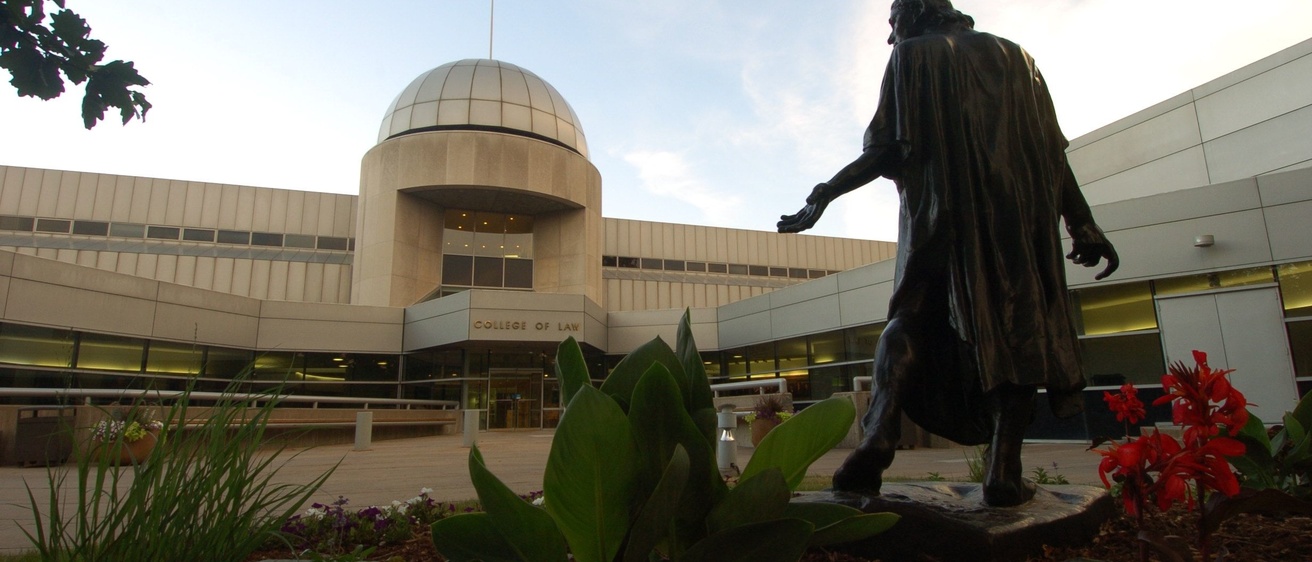The Boyd Law Building sculpture
The sculpture of Jean de Fiennes owned by the University of Iowa is displayed as Rodin would have him viewed: on a low pedestal, almost at ground level. This bronze sculpture is in every way an original work of art by Auguste Rodin, even though it was cast posthumously. In 1916, a year before his death, Rodin gave all his original sculpture to the French government. According to French law, casting is restricted to eight copies with another four restricted to public collections. The bronze Jean de Fiennes in the courtyard of the Boyd Law Building is the twelfth and final cast that was made of the sculptor's model.
The magnificently sculptured Rodin figure stands at the main entrance of the Boyd Law Building. This seven-foot, 865-pound original bronze casting was acquired and set in place in 1987. Generous private sources, including a gift from Orville F. (JD 1927) and Paula Grahame of Worcester, Massachusetts, together with Art in State Buildings (AISB) funds were combined to bring this work of the great French artist to Iowa City. The Grahame Courtyard in which Jean de Fiennes stands was named in honor of the Grahames.
Jean de Fiennes by Auguste Rodin
Jean de Fiennes is one of six separately cast figures included in Rodin's monumental work The Burghers of Calais, commissioned by the town of Calais in 1884 and completed in 1895. The work memorializes the actions of six leading French citizens of Calais who volunteered to surrender and to be put to death in order to end a siege of the town by the English King, Edward III, during the early years of the Hundred Years' War (1337-1453).
In 1347, Jean de Fiennes was the captain of the town of Calais, which had been under siege for more than six months. In order to save the town from annihilation, Jean opened the gates, and with a rope around his neck, came into the presence of the English King. Five other knights and burghers followed, bare-headed, bare-legged, bare-footed, and in their shirts, also having ropes around their necks. These six burghers believed that God would be merciful to them in return for their sacrifice. Jean offered the King a warrior's sword, the keys to the city, and a request for mercy and pardon for the citizens of Calais. Edward's acceptance of their heroic offer is one of the earliest recorded negotiated peace settlements in modern history. Intercession by the English queen ultimately spared the lives of the Burghers. This event was recorded by two contemporary chroniclers, Geoffrey le Baker, an Englishman, and Jean de Froissart, a Frenchman. From 1767 to 1884, several attempts were made by the town of Calais to commemorate this historic event, but no lasting memorial was established. Finally, in 1884, the city of Calais approached Auguste Rodin, a French sculptor, to make a permanent memorial.
Auguste Rodin (1840-1917)
Auguste Rodin lived from 1840-1917, at a time when sculpture had lost its artistic pre-eminence to pictorial media. Romanticism, Impressionism, Realism, and Symbolism were then concurrent movements in pictorial representation. Even so, Rodin preferred to work with sculptural media, but he assimilated and synthesized the pictorial forms to give them expression in his clay models. His technique and sense of formalism aligned him with the Impressionists of the 19th century, but his themes were Romantic. Through Rodin's figurative sculpture, sculpture regained its prominence; his art presided over the opening of the 20th century. Today, Rodin maintains his artistic prominence.
The Burghers of Calais is composed of six distinct figures, each of which, through posture and facial expression, depicts distinct reactions to this sacrifice: despair, resignation, and quiet defiance. Rodin planned the monument to stand on a low pedestal in the marketplace of Calais, as if the figures were beginning their walk to the English army. But the Calais commissioners rejected this proposal and placed the grouping on a medium-height base in front of a public garden, set off by a fence. Only after Rodin's death was the monument moved in front of the Town Hall and put on a low-pedestal. Collectively, the six figures represent the story of the burghers' act on behalf of their town. However, each figure can stand alone as a great work of art, expressive of universal human emotions.
Jean de Fiennes, the youngest of the six, is portrayed with a boyish torso, arms extended, and palms up. Tattered drapery falls down his arms and around his feet, concealing his movement. He displays a puzzlement about his fate. As he confronts the capriciousness of life, he poses the question, Why? Jean's facial expression portrays a doubting disposition as he looks back toward the town he may never see again. He appears not to have come to terms with his fate. The notions of self-sacrifice to the greater good and humane justice that underlie the Burghers' episode, coupled with the eternal curiosity of youth that Jean symbolizes, make the statue truly appropriate for the Law Building site. Critics have suggested that Jean should be viewed by walking counter-clockwise around the figure, thereby gaining the impression that he is walking to his fate with the English Army.
